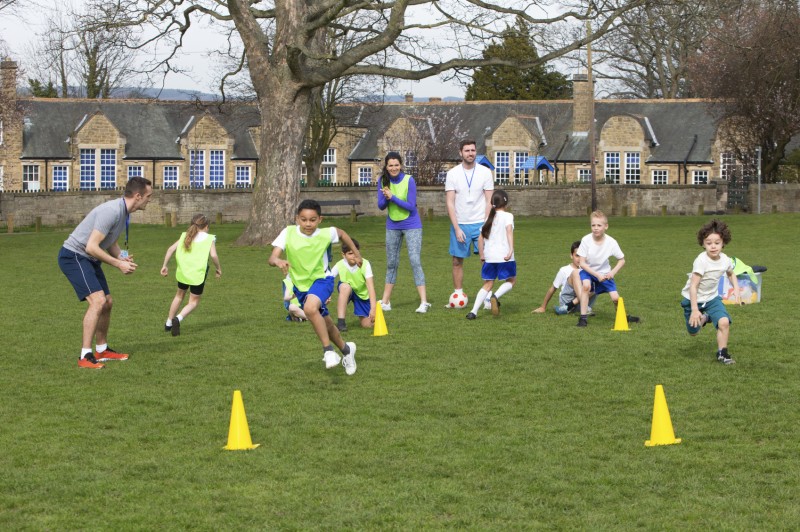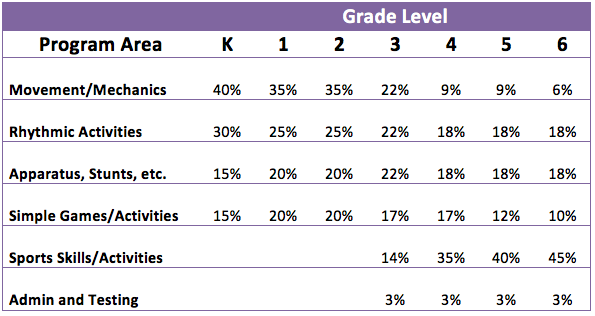
With physical education getting chased from schools these days, I thought the elitefts readership might be interested in a look at American PE instruction when it was likely in its most structured and challenging era. For a reference text, I’ll use Victor Dauer and Robert Pangrazi’s Dynamic Physical Education for Elementary School Children, 5th Edition (1975), which first went to press in 1962 under Dauer’s solo authorship. It’s a classic text in the field, and its 18th edition was released last year.
My copy is actually my dad’s old textbook, a relic from the days before he realized the privilege of educating teenagers might eventually drive him into a homicidal rage. Reading it, I’m surprised how much of it still fits into modern sport/athletic theory; perhaps its biggest sign of age is its reliance on what today would be questionably named exercises, e.g., “Japanese tug-of-war,”* and a few others like “slave twist.”
RELATED: Speed and Conditioning for the Youth Athlete
I was impressed with how much relevance it still held to today’s practice of athletics. In proving that there’s little that’s truly new in the world of training, just about all of the (useful) mobility and stability drills that are out there make an appearance somewhere in the text. The focus on rolls and tumbling reminded me of Joe Kenn and others integrating these exercises into sport training over the past few years. And the fact that that the structural approach here was adopted in the 1950’s in response to Central European excellence in fitness brought to mind western strength and conditioning’s embrace of Eastern Bloc methods and terminology.
Program Areas for Physical Education
Dauer and Pangrazi organize class activities into eight broad categories:
Fitness Routines and Activities: Work to build a base of fitness (cardio capacity, strength, mobility, balance, etc.) performed for 5-6 minutes at the beginning of class. Includes jogging, push-ups, crawls, skipping, etc., often performed in circuits. (In strength-training terms, this is sort of a combination of warm-ups and GPP.)
Movement Experiences and Body Mechanics: Development of posture, general balance and proprioception, locomotor skills (walking, jumping, etc.), nonlocomotor skills (pushing, pulling, twisting, turning, etc.), and manipulative skills to develop hand- and foot-eye coordination.
Rhythmic Activities: Activities performed with a beat, whether simple claps or touches done at a cadence, to dancing to music.
Apparatus, Stunts, Tumbling, and Combatives: Apparatuses include ladders, ropes, boxes, etc.; stunts and tumbling include gymnastic-style activities starting with rolls and culminating in cartwheels, handstands, diving into rolls, group pyramids, etc.; and combatives include tug-of-war, finger-fencing, Mas wrestling (here called a Chinese pull-up), hand wrestling, shoving, etc. Combatives begin in fourth grade.
Simple Games and Relays: Tag, ball tosses, dodgeball, and relays with handing off various implements using any kind of locomotion, including on scooters.
Sports Skills and Activities: Complex sports such as basketball, football, track and field, hockey, and drills associated with these sports.
Administration and Testing: The usual timed events and max-rep tests, along with administering awards, and integrating biological/exercise science education into physical activities.
Swimming and Water Safety: All pool-based activities. These can be broken into/associated with the previous categories.
Program Emphasis by Grade Level
Dauer and Pangrazi generally recommend that lower grade levels (K-3, roughly) focus more on basic skill acquisition and development, while the use of games is considered “the frosting on the cake.” Grade 4 onwards focuses increasingly on advanced movements skills and complex sports. With this in mind, they use the categories cited above to help craft lesson plans revolving around yearly exposure percentages that are differentiated by grade level. Their recommendations are charted below. Since they consider Fitness Routines and Activities to be fixed blocks for every class session, they aren’t included in the chart. Swimming-related activities aren’t included because access to pools was (and remains) highly variable across schools and school systems.
Example Activities
I was a child of the 90’s, and if I think hard enough I can see how my PE experience followed the rubric above — I’d even guess that more than a few of my teachers learned from the same text. Though my time in school predated the worst of gym-slashing, I was firmly in the era of high safety and low student fitness. So from this perspective, much of Dauer and Pangrazi’s book takes the form of an encyclopedia of exercises that I never would’ve come across. Here are some that caught my eye either because they struck me as new and useful, seemed like they would’ve been fun, and/or because you’d get fired for trying them in class today:
Catch and Pull Tug of War: “Two teams face each other across a line. The object is to catch hold of and pull any opponent across the line.”
Thread the Needle: “Touch the fingertips together in front of the body. Step through with one foot at a time without the tips losing contact. Step back to the original position. Now lock the fingertips in front of the body and repeat the stunt. Finally, see if children can step through the clasped hands without touching the hands.”
Turk Stand: “Stand with feet apart and arms folded in front. Pivot on the balls of both feet and face the opposite direction. The legs are now crossed. Sit down in this position. Reverse the process. Get up without using the hands for aid, and uncross the legs with a pivot to face original direction.”
Knee Dip: “Grasp the right instep behind the back with the left hand, balancing on the left foot. With the other arm out for balance, lower and touch the floor with the bent knee. Regain balance.”
Flying Dutchman: One student lies on his back and raises his legs perpendicular to the floor. A second student then lies across the first student’s feet and strikes a Superman pose.
Finger Fencing: “Contestants stand on right foot and hold the left foot with the right hand. Hook index fingers of the right hand and try to push opponent off balance. Change feet and hands. Any movement of the supporting foot loses.”
Pyramids: Human stacking activities that fall between cheerleading and Cirque du Soleil.
RELATED: Reintroducing the Jump Rope: The First 6 Weeks
Conclusion
I think the content I share above (with the exception of a few exercises) could be implemented right away by, for example, a youth sport coach either donning the whistle for the first time or just looking to better organize practices. Altogether, very little in the text struck me as outdated, and a glance at the chapters in the latest edition show that not much has changed in terms of broad content, save for sections covering legal liability, general health topics, and a few other additions. As someone whose (very modest) physical skills developed after he out-aged his participation in PE, it was interesting to see the reasons behind practices that may have deterred me from exercise in my youth; in the same context, I’m surprised to find so many that I now consider critical to effective fitness training.
*As described in Dauer and Pangrazi, this activity bears little resemblance to the instructional films found on various adult video sites.













1 Comment